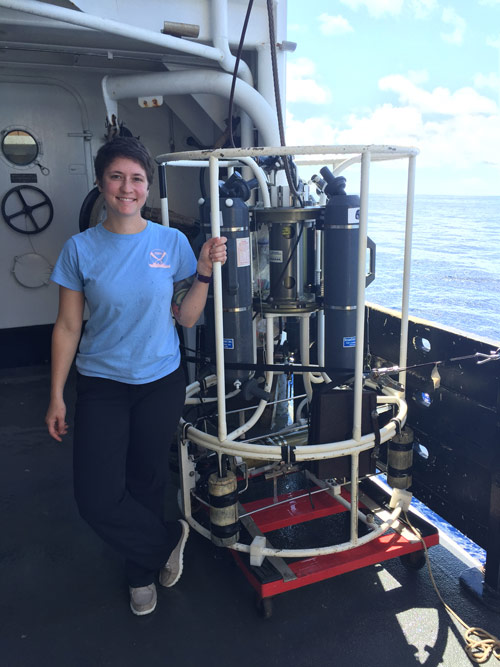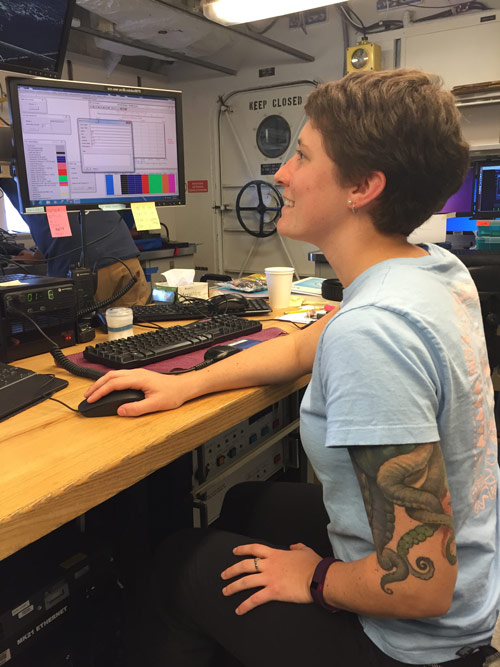
By Danielle Power, Senior Survey Technician, NOAA Ship Pisces
September 1, 2016

Danielle and the CTD rosette aboard NOAA Ship Pisces. Image courtesy of the Exploring Carolina Canyons expedition. Download larger version (jpg, 3.2 MB).
My days all begin the same. I wake up to my alarm, roll out of my comfortable bed, and head to breakfast (my favorite meal of the day). The promise of hot coffee helps, too.
After breakfast, things tend to get a bit more unpredictable. My days can be very high tempo or very low tempo, scarcely anything in between. My job may require me to be on watch for 12-hour days, 12-hour nights, or something in the middle. While most vessels that conduct 24-hour operations have two survey technicians, NOAA Ship Pisces has only one. So my schedule is often 12-hours on and 12-hours on-call. It definitely keeps me busy!
The core of my job as a survey technician is data collection and management. My responsibilities range from managing mapping efforts; running scientific computer system events, deploying the CTD (conductivity, temperature, and depth) rosette; helping to sort and collect fish data; working on standard operating procedures (SOPs) and pass downs; and generally being available if anything goes wrong or if the scientists or crew need help. My duties change with each cruise, since different science objectives require varying tasks.
Most of the shipboard systems run smoothly once we start them up for the field season, so I generally only need to monitor the status of our oceanographic and meteorological sensors while at sea. This leaves time for other tasks, particularly multibeam mapping. The Pisces is equipped with a Simrad ME70, which is a fisheries multibeam echosounder. It was originally built as a water column sonar, but NOAA’s fleet has used this system for bathymetric mapping. Because we’ve adapted the system to better suit our needs, it can be one of the more challenging systems to troubleshoot.

Danielle monitoring data in real-time during a CTD deployment. She communicates with the deck and bridge throughout the operation. Image courtesy of the Exploring Carolina Canyons expedition. Download larger version (jpg, 3.1 MB).
Nevertheless, thanks to the hard work from myself, the on-board electronics technicians, and our shore support staff, we’ve had an incredibly successful year. We have mapped more area and collected higher quality data than ever before. The system isn’t without its hiccups and it continues to be a work in progress, but overall I’m happy with how far we’ve come in the last year.
However, mapping isn’t all I do in a day’s work! Certain science parties that come on board let me help with collecting and recording fishery data from their fish traps and bandit reels (large fishing reels mounted on the main deck). If I am not needed for science operations, I work to find ways to improve our ship’s scientific systems. This can include updating SOPs or finding ways to rework current survey systems to make them more efficient.
Even if I find myself lacking a task, there’s always something that needs to be worked on or a department who could use an extra set of hands or eyes. Though my days all begin the same, no two days on the Pisces are ever the same—and that’s really a day in the life of a survey technician.